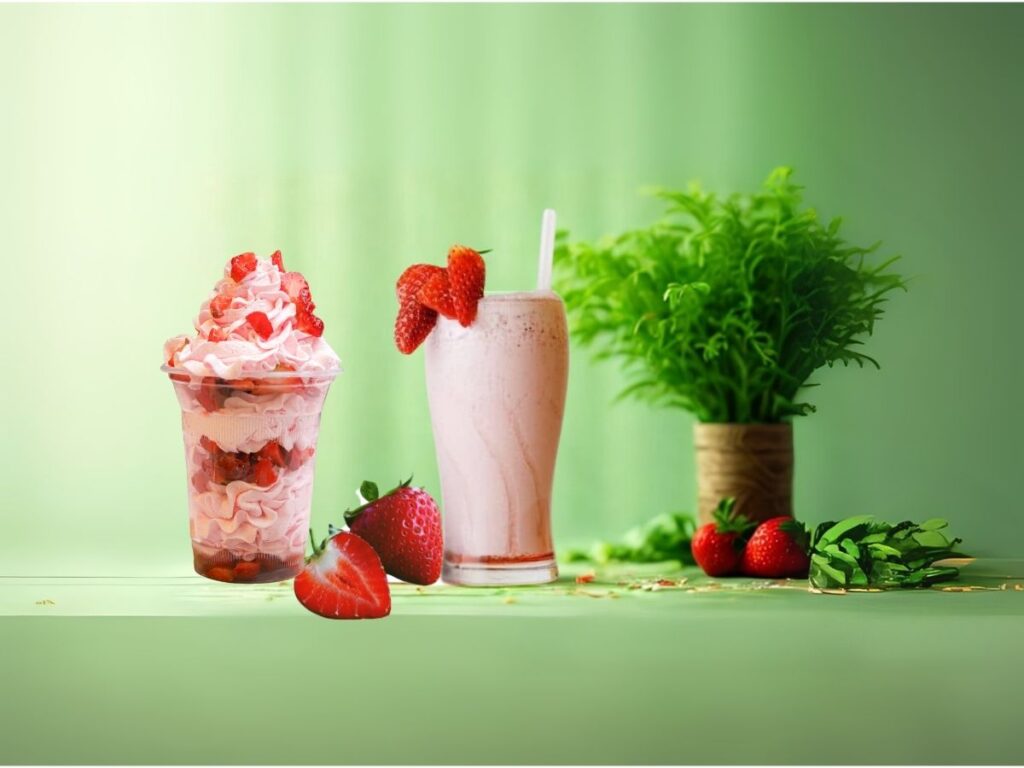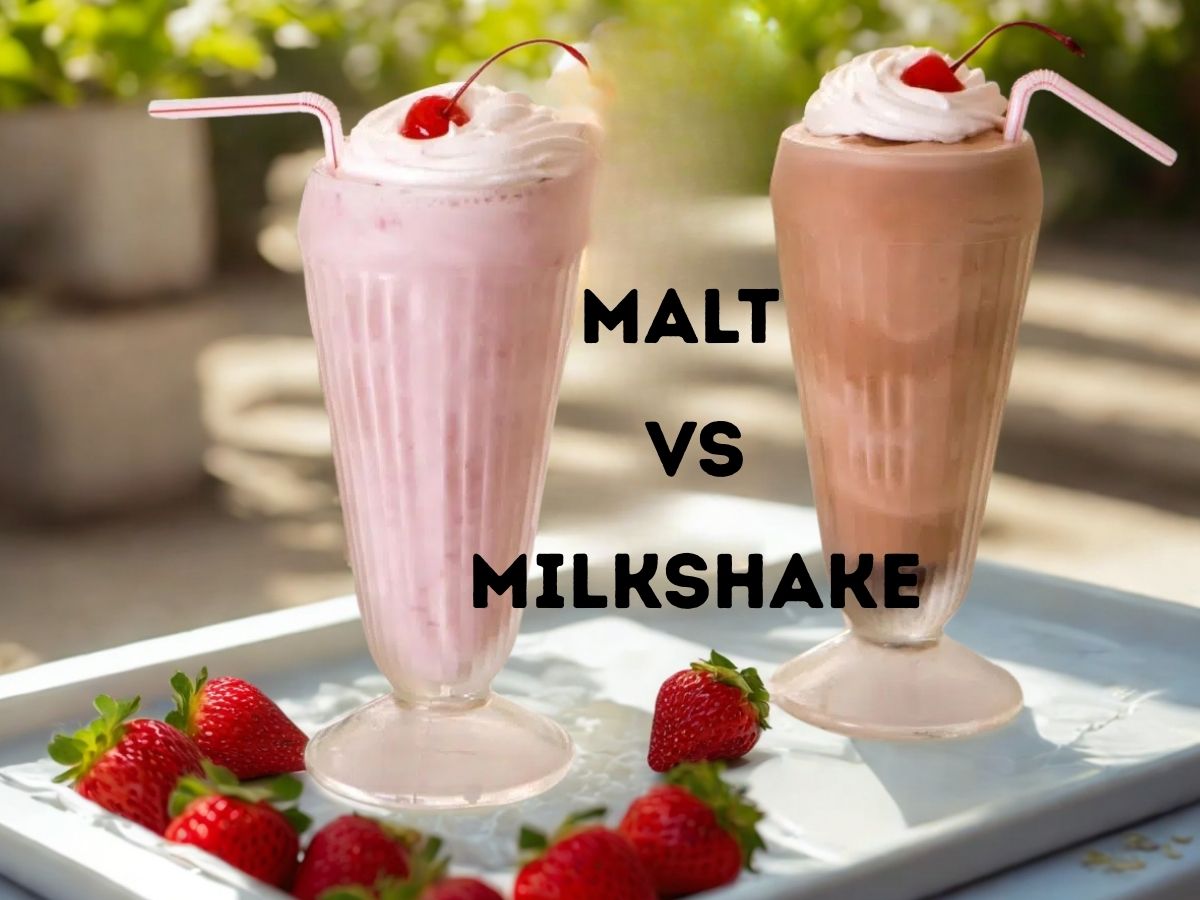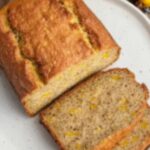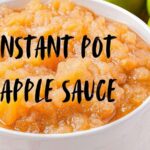The malt vs milkshake debate has been going on for decades in diners, ice cream shops, and kitchens across America. While both drinks are creamy, sweet, and delicious, they have distinct differences that make each one special. Understanding the key differences between malt vs milkshake helps you choose the perfect treat for your taste preferences and dietary needs.
Both drinks start with similar base ingredients – ice cream, milk, and flavorings – but the addition of malted milk powder creates a completely different taste experience. This simple ingredient transforms an ordinary milkshake into something with deeper, more complex flavors that many people find irresistible.
What is a Malt?
A malt, also known as a malted milkshake, is a thick beverage made with:
- Ice cream
- Milk
- Flavoring
- Malted milk powder (the key differentiator)
Malted milk powder is made from:
- Malted barley
- Wheat flour
- Evaporated whole milk
The malting process involves germinating grains and then drying them, which gives the powder its unique flavor profile.
What is a Milkshake?
A milkshake is a sweet, cold beverage made by blending:
- Ice cream
- Milk
- Flavorings (like chocolate syrup, vanilla, or fruit)
Unlike malts, milkshakes do not contain malted milk powder.
What is Malted Milk Powder?
What is malted milk powder? This is the key ingredient that makes the difference in the malt vs milkshake comparison. Malted milk powder is a fine, beige-colored powder made from malted barley, wheat flour, and evaporated whole milk.
Production Process:
- Barley grains are soaked in water and allowed to germinate
- The sprouted grains are dried and ground into malt
- The malt is mixed with wheat flour and evaporated milk
- Now dried and ground this mixture in a very fine and smooth powder
Nutritional Components:
- Natural sugars from the malting process
- Proteins from milk and grains
- B vitamins, especially B6 and folate
- Minerals like calcium and iron
- Natural enzymes from the malting process
Malts vs Milkshakes: Key Differences
| Features | Malt | Milkshake |
| Ingredients | Ice cream + milk + flavorings + malted milk powder | Ice cream + milk + flavorings (no malt powder) |
| Flavor Profile | Rich, slightly nutty, and complex flavor with a distinctive malty taste | Clean, straightforward flavor that highlights the ice cream and added ingredients |
| Sensory Properties 1- Taste 2- Texture 3- Appearance | More complex, nutty, sweet, toasty Thicker and denser due to the malted milk powder which gives mouth feel. Slightly more opaque | Simpler, more direct Smoother and lighter Brighter and more vibrant |
Nutritional Value Malt vs Milkshake
| Nutritional value | Typical Malt (12 oz serving) | Typical Milkshake (12 oz serving) |
| Calories (kcal) | 350-450 | 300-400 |
| Macronutrients Protein Carbohydrates Fat Fiber | 10-12g 45-55g 15-20g 1-2g | 8-10g 40-50g 12-18g 0-1g |
Vitamins and Minerals
Both beverages provide similar nutritional benefits from their dairy content:
Common Nutrients:
- Calcium: Essential for bone health
- Vitamin D: Supports calcium absorption
- Riboflavin (B2): Important for energy metabolism
- Phosphorus: Supports bone and teeth health
Malt Advantage: The malted milk powder in malts provides additional B vitamins, particularly:
- Thiamine (B1)
- Niacin (B3)
- Vitamin B6
Sugar Content
Both drinks are high in sugar, but malts may contain slightly more due to the natural sugars in malted milk powder. A typical serving contains 35-45 grams of sugar.
Popular Recipes

Classic Chocolate Malt Recipe
Ingredients:
- 3 scoops vanilla ice cream
- 1/2 cup whole milk
- 3 tablespoons chocolate syrup
- 2 tablespoons malted milk powder
- Whipped cream for topping
Instructions:
- Add ice cream, milk, chocolate syrup, and malted milk powder to a blender
- Blend on high for 30-45 seconds until smooth and creamy
- Pour into a chilled glass
- Top with whipped cream
- Serve immediately with a thick straw
Vanilla Malt Recipe
Ingredients:
- 3 scoops vanilla ice cream
- 1/2 cup milk
- 2 tablespoons malted milk powder
- 1 teaspoon vanilla extract
- Pinch of salt
Instructions:
- Blend all ingredients until smooth
- Adjust consistency with more milk if needed
- Serve in a chilled glass
- Dust with a little extra malt powder on top

Strawberry Milkshake Recipe
Ingredients:
- 3 scoops strawberry ice cream
- 1/2 cup milk
- 1/4 cup fresh strawberries (hulled)
- 1 tablespoon strawberry syrup
- strawberry chunks and whipped cream for garnish
Instructions:
- Combine ice cream, milk, strawberries, and syrup in a blender
- Blend until smooth and creamy
- Taste and adjust sweetness if needed
- Pour into a tall glass
- For garnish use strawberry chunks and whipped or fresh cream
Chocolate Peanut Butter Milkshake
Ingredients:
- 3 scoops chocolate ice cream
- 1/2 cup milk
- 2 tablespoons peanut butter
- 1 tablespoon chocolate syrup
- Crushed peanuts for topping
Instructions:
- Blend ice cream, milk, peanut butter, and syrup
- Pour into glass
- Top with crushed peanuts
- Serve with whipped cream if desired
Preparation Methods
Traditional Method (Hand-Mixed)
The old-fashioned way involves using a milkshake mixer or manual stirring:
- Place ice cream in a large mixing cup
- Add milk gradually while stirring
- Mix in flavorings and malt powder (if making a malt)
- Stir vigorously until well combined
- Adjust consistency as needed
Blender Method (Most Common)
This is the easiest and most consistent method:
- Add all ingredients to blender in order: liquid first, then ice cream
- Pulse a few times, then blend on high
- Stop frequently to scrape sides
- Blend until desired consistency is reached
Milkshake Machine Method
Commercial establishments use specialized machines:
- Pre-chill the mixing cup
- Add ingredients in proper proportions
- Use the machine’s mixing attachment
- Mix for 15-30 seconds depending on desired thickness
Frozen Method
- Pre-mix ingredients and freeze in ice cube trays
- Blend frozen cubes with small amount of milk
- Creates extra-thick consistency Best For: Make-ahead preparation, ultra-thick texture
No-Ice-Cream Method
Ingredients: Frozen bananas, milk powder, malt powder, sweetener
Process: Blend frozen fruit with powders and liquid
Best For: Healthier alternatives, dairy-free options
Tips for Perfect Results
For Malts:
- Use high-quality malted milk powder for best flavor
- Let the malt powder dissolve completely
- Start with less liquid and add more as needed
- Chill glasses beforehand for optimal temperature
For Milkshakes:
- Use slightly softened ice cream for easier blending
- Don’t over-blend to avoid thin consistency
- Taste and adjust flavorings before serving
- Use whole milk for creamiest results
Malt vs Milkshakes: Which Is Healthier?
Is malt healthier than milkshakes? The answer involves several nutritional factors:
Nutritional Advantages of Malts:
- Higher Protein Content: Malts typically contain 12-15g protein vs 8-10g in milkshakes
- B Vitamins: Malted milk powder provides B6, folate, and other B vitamins
- Minerals: Additional calcium, iron, and magnesium from grain sources
- Enzymes: Natural enzymes from the malting process may aid digestion
Nutritional Disadvantages of Malts:
- Higher Calories: 60-80 more calories per serving
- More Carbohydrates: Additional sugars from malted grains
- Higher Sugar Content: Natural sugars plus any added sweeteners.
Health Considerations
Malt vs milkshake is a big debate both are treat beverages that should be enjoyed in moderation. They are high in calories, sugar, and saturated fat. However, they do provide some nutritional benefits:
Benefits:
- Good source of calcium and protein
- Provides energy for active individuals
- Contains essential vitamins and minerals
Considerations:
- High calorie content
- Significant sugar content
- May not be suitable for those with lactose intolerance
- Can contribute to weight gain if consumed regular.
Is a Milkshake or Malt Better?
Malt vs Milkshake which one is better? This depends entirely on your personal preferences, dietary needs, and the occasion:
Milkshakes Are Better When:
- You want quick refreshment
- You prefer simple, clean flavors
- You’re looking for a lighter treat
- You want to taste the primary flavor clearly
- You’re serving children who prefer familiar tastes
Malts Are Better When:
- You want a more filling, substantial treat
- You enjoy complex, sophisticated flavors
- You appreciate nostalgic, old-fashioned drinks
- You want higher protein content
- You prefer thicker textures
Situational Preferences:
- Hot Summer Days: Milkshakes win for refreshment
- Comfort Food Moments: Malts provide more satisfaction
- After Exercise: Malts offer better protein recovery
- Quick Treats: Milkshakes are easier to consume quickly
Storage and Serving Tips
Serving Guidelines
| Aspect | Recommendation | Why It Matters |
| Glass Temperature | Chill glasses in freezer for 10-15 minutes | Maintains beverage temperature longer |
| Serving Size | 12-16 oz for adults, 8-10 oz for children | Appropriate portion control |
| Straw Type | Wide bore straws or long spoons | Accommodates thick consistency |
| Serving Time | Immediate consumption preferred | Prevents separation and temperature loss |
| Garnish Timing | Add just before serving | Maintains visual appeal and freshness |
Storage Comparison
| Storage Method | Malt | Milkshake | Duration | Quality |
| Room Temperature | Not recommended | Not recommended | 30 minutes max | Poor |
| Refrigerated | Acceptable with stirring | Acceptable with stirring | 2-3 hours | Fair |
| Frozen (as popsicle) | Good alternative | Good alternative | 1-2 weeks | Good |
| Freezer (liquid) | Becomes too hard | Becomes too hard | Not recommended | Poor |
Professional Presentation:
Serving Style:
- Use tall glasses that hold at least 12-16 ounces
- Provide both thick straws and long spoons
- Garnish with whipped cream, cherries, or cookies
Make-Ahead Tips:
- Pre-measure dry ingredients in containers
- Partially blend and store in freezer for quick finishing
- Keep glasses chilled for immediate service
Troubleshooting Common Issues:
- Too Thin: Add more ice cream or malt powder
- Too Thick: Add cold milk one tablespoon at a time
- Clumpy Malt: Sift powder before adding, blend longer
- Not Cold Enough: Use frozen fruit or add small amount of crushed ice
Frequently Asked Questions
Is malt the same thing as a shake?
No, malt and shake are different drinks. A shake contains ice cream, milk, and flavorings. A malt includes all those ingredients plus malted milk powder, which creates a thicker texture and more complex, nutty flavor profile.
Is malt healthier than milkshakes?
Malts contain more protein and B vitamins than regular milkshakes due to the malted milk powder. However, they also have more calories and sugar. Neither is particularly healthy as a regular beverage, but malts do offer slightly more nutritional value per serving.
What does malt mean in milk?
Malt in milk refers to malted milk powder, which is made from malted barley, wheat flour, and evaporated milk. When added to milk-based drinks, it creates nutty, caramel-like flavors and increases thickness and nutritional content.
Why are malts thicker than milkshakes?
Malts are thicker because malted milk powder absorbs liquid and adds solid particles to the mixture. The powder contains proteins and starches that naturally thicken the drink, making it more substantial than a regular milkshake.
Can I make a malt without malted milk powder?
No, malted milk powder is essential for creating a true malt. Without it, you simply have a milkshake. However, you can make similar flavors using malt extract or barley malt syrup, though the texture and taste will be different.
How much malted milk powder should I use?
For a 12-ounce serving, use 2-4 tablespoons of malted milk powder. Start with less and add more to taste. Too much powder can make the drink overly thick and overpower other flavors.
Do malts cost more than milkshakes?
Yes, malts typically cost $0.50-$1.00 more than milkshakes at restaurants because malted milk powder is more expensive than regular flavorings. The additional ingredients and preparation time also contribute to higher prices.
Conclusion
The malt vs milkshake comparison reveals two distinct treats that serve different purposes and preferences. While milkshakes offer clean, refreshing flavors and lighter textures, malts provide complex, sophisticated tastes with more substantial consistency and higher nutritional value.
you can make your choices based on your mood, dietary needs, and flavor preferences more easier and frequent by understanding the difference. Whether you prefer the simple pleasure of a classic milkshake or the rich complexity of a traditional malt, both drinks represent timeless American treats that continue to satisfy people of all ages.









